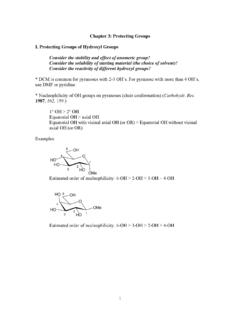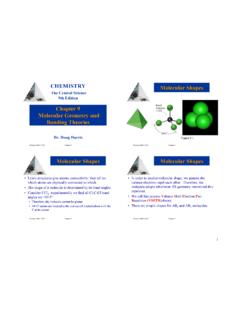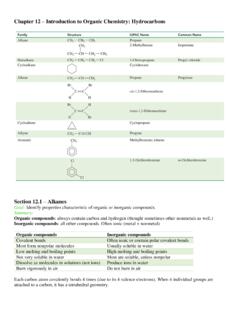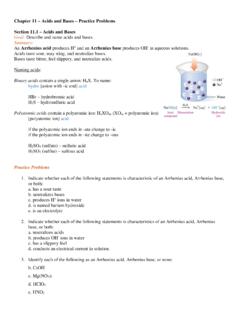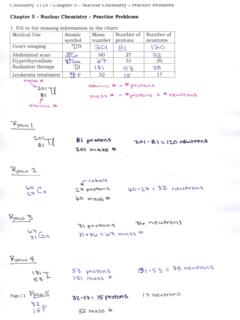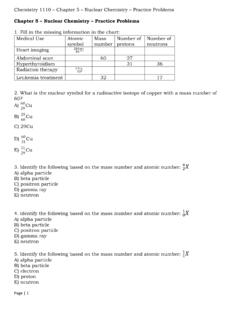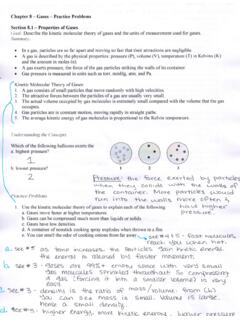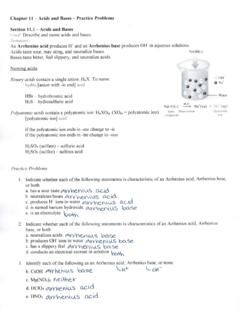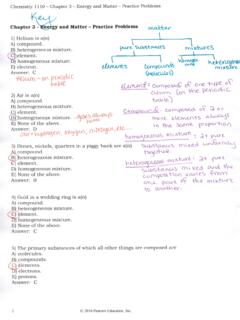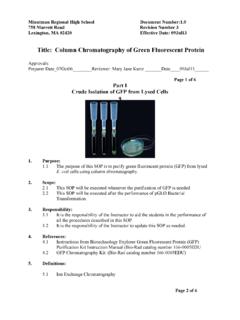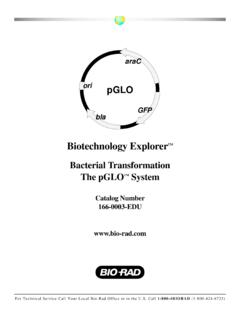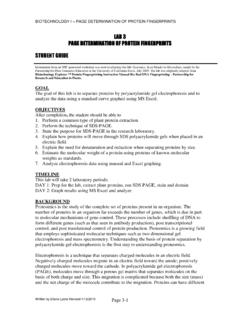Transcription of Chromosome 16: PV92 PCR - Utah State University
1 Chromosome 16: pv92 PCR A Bio-Rad biotechnology explorer Experiment Introduction to PCR The Polymerase Chain Reaction You are about to perform a procedure known as PCR1 the amplification of a specific sequence of your own DNA in a test tube. This particular piece of DNA is present in the genes of many but not all people. Analysis of the data generated in this laboratory will enable you to determine whether your genomic DNA carries this piece of DNA, or not. The genome, composed of DNA, is our hereditary code. This is the so-called "hard-wiring", the blueprint that controls much of why we look like we do, why we act like we do, and how we do the things we do. Molecular biology is the study of genes and the molecular details that regulate the flow of genetic information from DNA, to RNA and proteins, from generation to generation. biotechnology uses this knowledge to manipulate organisms' (microbes, plants or animals) DNA to help solve human problems.
2 Within the molecular framework of biology, DNA, RNA and proteins are closely tied to each other. Because proteins and enzymes ultimately play such a critical role in the life process, scientists have spent many lifetimes studying proteins in an attempt to understand how they work. With this understanding it was believed we could cure, prevent and overcome disease and physical handicaps as well as explain exactly how and why organisms exist, propagate and die. However, the complete answer to how and why does not lie solely in the knowledge of how enzymes function, we must learn how they are made. If each enzyme is different, then what controls these differences and what is the blueprint for this difference? That answer lies within our genome, or genetic code. Thus, you may realize why researchers today, in an attempt to understand the mechanisms behind the various biological processes, study nucleic acids as well as proteins in order to get a complete picture.
3 In the last 20 years, many advances in the areas of nucleic acid techniques have allowed researchers the means to study the roles that nucleic acids play in biology. It took the imagination and hard work of many scientists to reveal the answers to one of the most mysterious puzzles of life understanding the mechanisms that control how DNA is translated into proteins within living cells. PCR Set the Stage for a Scientific Revolution In 1983, Kary Mullis2 at Cetus Corporation developed the molecular biology technique that has since revolutionized genetic research. This technique, termed the polymerase chain reaction (PCR), transformed molecular biology into a multidisciplinary research field within 5 years of its invention. Before PCR, the molecular biology techniques used to study DNA required such a high level of expertise that relatively few scientists could use them. The objective of PCR is to produce a large amount of DNA in a test tube (in vitro), starting from only a trace amount.
4 Technically speaking, this means the controlled enzymatic amplification of a DNA sequence, or gene, of interest. The template strands can be any form of double-stranded DNA such as genomic DNA. A researcher can take trace amounts of genomic DNA from a drop of blood, a single hair follicle or cheek cell (in theory, only a single template strand is needed to copy and generate millions of new identical DNA molecules) and make enough to study. Prior to PCR, this would have been impossible. It is the ability to amplify the precise sequence of DNA of interest that is the true power of PCR. PCR has made an impact on four main areas of genetic research: gene mapping, cloning, DNA sequencing and gene detection. PCR is now used as a medical diagnostic tool to detect specific mutations that may cause genetic disease3, is used in criminal investigations and courts of law to identify suspects on the molecular level4, and has been a powerful tool in the sequencing of the human genome5.
5 Prior to PCR the use of molecular biology techniques for therapeutic, forensic, pharmaceutical, agricultural or medical diagnostic purposes was not practical nor cost effective. The development of PCR technology transformed molecular biology from a difficult science to one of the most accessible and widely used disciplines of biotechnology . Now, let s extract some of your own DNA. Procedure for DNA Extraction and Template Preparation To obtain DNA for use in the polymerase chain reaction you will extract the DNA from your own living cells. It is interesting to note that DNA can be also extracted from mummies and fossilized dinosaur bones. In this lab activity, you will be isolating DNA from epithelial cells that line the inside of your cheek . This is accomplished by using a sterile pipet tip to gently scrape the inside of both your cheeks about 10 times each to scoop up the cells lining the surface. You will then boil the cells to rupture them and release the DNA they contain.
6 To obtain pure DNA for PCR you will use the following procedure. The cheek cells in the pipet tip are transferred into a micro test tube containing 200 l of InstaGene matrix. This particulate matrix is made up of negatively charged microscopic beads that "chelate", or grab metal ions out of solution. It acts to trap metal ions, such as Mg2+, which are required as catalysts or cofactors in enzymatic reactions. Your cheek cells will then be lysed or ruptured by heating to release all of their cellular constituents, including enzymes that were once contained in the cheek cell lysosomes. Lysosomes are sacs within the cells cytoplasm that contain powerful enzymes, such as DNases, which are used by cells to digest the DNA of invading viruses. When you rupture the cells, these DNases can digest the released DNA of interest. However, when the cells are lysed in the presence of the chelating beads, the cofactors are adsorbed and are not available to the enzymes.
7 This virtually blocks all enzyme degradation of the extracted DNA and results in a population of intact genomic DNA molecules that will be used as the template in your PCR reaction. Your isolated cheek cells are first suspended in the InstaGene matrix and incubated at 56 C for 10 minutes. This "preincubation" step helps to soften the plasma membranes and release clumps of cells from each other. The increased temperature also acts to inactivate enzymes such as DNases, which will degrade the DNA template. After this 10 minute incubation period, the cells are then placed into a boiling (100 C) water bath for 6 minutes. The boiling ruptures the cells and releases the DNA from the cell nucleus. Your extracted genomic DNA will then be used as the target template for PCR amplification. DNA Extraction and Template Preparation Workstation Checklist Your workstation. Materials and supplies that should be present at your workstation prior to beginning this lab are listed below.
8 Student workstations Number ( ) Screwcap tubes with InstaGene matrix 8 Styrofoam microtube rack 2 P-20 micropipet 1 P-200 micropipet 1 Pipet tips (filter type), 20 200 l 1 box Lab marker 1 Waste container 1 Copy of Quick Guide or protocol 1 Instructor's (common) workstation.
9 A list of materials, supplies, and equipment that should be present at a common location to be accessed by your team is also listed below. P-200 micropipet 1 8 Pipet tips (filter type), 20 200 l 1 box Water baths (56 and 100 C) 2 Centrifuge 1 Lab Protocol 1. Each member of your team should have two screwcap tubes, each containing 200 l of InstaGene matrix. Label the tube on the cap and on the side with your initials. In addition, label the tubes as "tube 1" and "tube 2". Each person should wash his or her hands before beginning step 2. 2.
10 Using a sterile 20 200 l filter pipet tip, gently scrape the inside of both cheeks 10 times each with the tip. This is most easily done by pinching and extending the corner of your mouth with one hand, and scraping the cheek with the tip in the other hand. Use firm, but gentle pressure. The goal is to remove the surface layer of epithelial cells from your cheek lining. You should see a small volume of white cells in the pipet tip. 3. Place the tip that contains your cheek cells into the screwcap tube labeled as "tube 1". 4. Using a second sterile 20 200 l filter pipet tip, gently scrape the inside of both cheeks 10 times each with the tip. Place the tip that contains your cheek cells into your screwcap tube labeled as "tube 2". 5. Place the tips on the end of a P-200 micropipet that is set on a 100 l setting. Pipet up and down 5 times into the InstaGene matrix the action of pipetting up and down mixes and transfers your cheek cells into the InstaGene matrix.
